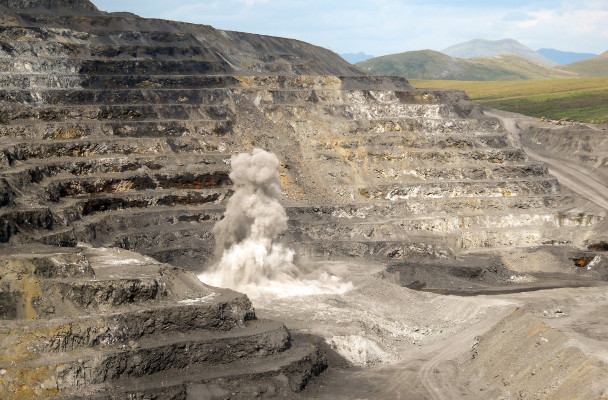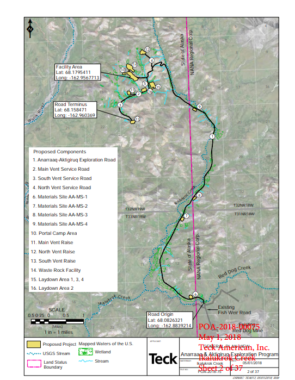
One of Alaska’s largest mines is moving toward a significant expansion, applying for state and federal permits to build a 10-mile road to a pair of new prospects in a remote part of Northwest Alaska.
The 30-year-old Red Dog Mine has generated profits for its operator, Canadian mining company Teck. Teck, in turn, pays hundreds of millions of dollars in yearly royalties to the Alaska Native regional corporation, NANA, that owns the land where the mine sits. It also hires hundreds of NANA shareholders.
But without a new source of zinc and lead, the money and jobs could disappear in less than 15 years, when Red Dog is expected to run out of ore. Teck’s planned road leads to a pair of new prospects, Anarraaq and Aktigiruq, that could extend the mine’s lifespan.
Teck has been drilling into the prospects from the surface, moving equipment by helicopter. Now, the company wants to do more intensive drilling from underground, and it wants to build the road to bring in heavy equipment, according to permitting documents that the company filed with the U.S. Army Corps of Engineers.
Teck, in a prepared statement from spokesman Chris Stannell, said it chose the route for the road in consultation with local elders and subsistence hunters. And it’s given helicopter tours to local leaders in nearby Kivalina, who get drinking water and fish from the Wulik River, in the same watershed as the mine.

A group of Kivalina residents sued the mine’s operators over wastewater discharge in 2004, in a case that was later settled. One said this week that she’ll be closely watching Teck’s expansion plans.
“We are not trying to close the mine down — we know that’s not going to happen. We just want them to be careful as much as they can,” said Janet Mitchell, a former village administrator. “We just want as little spills as possible and as little dust flying out in the air as possible. And they’ve been pretty good about that.”
The mine has been operating since 1989 and last year produced more than 500,000 tons of zinc. Its gross profit in 2017 was $971 million, according to Teck’s annual report, and the company paid $325 million in royalties to NANA, which distributes about two-thirds of the money to other Alaska Native corporations under federal law.
The mine also employs hundreds of Northwest Alaska residents and NANA shareholders.
Teck, in its annual report, said it expects Red Dog to run through 2031. It’s assessing the new deposits to see if it’s “economically and environmentally viable” to extend the mine’s operations past that date, Stannell said.
One key fact is that the new prospects are on state land, so NANA wouldn’t collect royalties like it does now — though the road to access the prospects does have to cross NANA land.
Teck applied with the Alaska Department of Natural Resources in June for permission to build the road, as well as pads for things like a camp and waste rock storage. The state published the plans Wednesday and said it would accept comments on them for two weeks.
Stannell said road construction is expected to start in mid-January, and the project will include a half-dozen steel bridges over creeks, according to Teck’s application with the state. Teck, Stannell added, is working with residents, elders and NANA “to ensure we conduct this work in a way that is protective of the environment, such as ensuring that water sources are protected and preventing any potential impacts to subsistence resources such as caribou.”
Some Kivalina residents have “grave concerns” about possible contamination to the Wulik River, said Millie Hawley, former president of Kivalina’s tribal council.
Teck’s new prospects are closer to the river than the mine’s current operations.
“But it doesn’t look like it’s going to get too close,” Hawley said. “We’ll just have to wait and see.”
